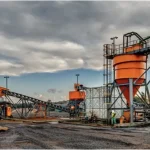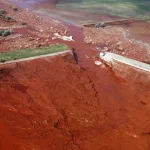The evaluation of static and cyclic liquefaction of mine tailings and soils is a key focus for tailings dam engineers, in response to the Global Industry Standard on Tailings Management (GISTM).
The pressure on International Council on Mining and Metals (ICMM) member mining companies to comply with the GISTM is growing, with the first deadline approaching in August 2023. By this time, all tailings storage facilities (TSFs) classified as having ‘Extreme’ or ‘Very high’ potential consequences will need to conform with the standard. In just two years after that date, all other sites will also need to demonstrate conformance.
The issue of liquefaction of mine tailings is among the key areas of concern in the industry, as it still presents itself as an important risk factor for TSF failure.
Static liquefaction is the sudden loss of strength when loose soil – typically granular material such as sand or silty sand – is loaded and cannot drain. Strength loss due to undrained failure can also be associated with fine-grained materials of low hydraulic conductivity, such as clays or plastic silts.
In the 2018 Jennings Lecture entitled “Critical State Soil Mechanics: 125 years of history to current use”, Mike Jefferies pointed out that soil liquefaction has been a concern to civil engineers for over 100 years, but that our understanding was continuing to evolve. As far back as 1936 Casagrande had come up with his concept of a critical void ratio, above which liquefaction failure could be expected. Today we know that the potential for liquefaction can be generally related to five important factors: relative density, confining pressure, peak pulsating stress, number of cycles of pulsating stress applied and the over-consolidation ratio.
Cyclic liquefaction refers to a loss of strength in a soil as a result of a buildup of porewater pressure caused by a seismic or dynamic loading.
According to Tinus Grobler, senior engineer at SRK Consulting, GISTM requirement 4.6 demands that mines ‘identify and address brittle failure modes with conservative design criteria, independent of trigger mechanisms, to organise their impact on the performance of the tailings facility’.
“These requirements necessitate the selection of conservative design criteria and operational material properties, so that risk related to all credible failure modes is organised,” said Grobler. The importance of static and cyclic liquefaction analysis in fact made it a focus of an international training course held in South Africa last year – attended by over 120 industry specialists. He said various methods of determining material parameters and analysis techniques were presented.
“It is important that material parameters are determined through a combination of both in-situ and laboratory testing,” he explained. “Also, analyses should be undertaken with carefully selected modeling methods and parameters.”
He noted that there was very limited availability of seismic data and research within the southern African region.
“With the GISTM calling for design criteria of up to the 1 in 10,000-year event, this calls for careful consideration of how seismic analyses are undertaken – as well as the increasing requirement for further research to firm up seismic parameters,” said Grobler.
The training course was organised by the Geotechnical Division of the South Africa Institution of Civil Engineering (SAICE) in collaboration with the Tailings and Industrial Waste Engineering Centre (TAILENG). A consortium of faculties at four US universities, TAILENG brings together expertise from Georgia Tech, Colorado State University, University of California Berkeley and the University of Illinois. It seeks to improve the fundamental understanding of the engineering properties of mine and industrial waste geomaterials – to promote resilient and sustainable infrastructure in the mining and power industries.
Perhaps the biggest take-away for delegates was the need to surround engineering problems and material characterisation with multiple tests and multiple approaches, to gain confidence in analyses, he said.
The world’s top names in this field were among the course presenters, including Professor Jonathan Bray of UC Berkeley, Professor Scott Olson of the University of Illinois, and Professor Jorge Macedo of the Georgia Institute of Technology.
Sessions were also presented by John Stiff of SRK Consulting South Africa, Ivan Wong of Lettis Consultants International in California, Colleen Crystal of SRK Consulting in North America, Christina Winckler of Anglo American Platinum, Gordon McPhail of Water, Waste and Land in Australia, Louis Geldenhuys of Jones and Wagener in Johannesburg, and Professor Eben Rust of Osimo.















